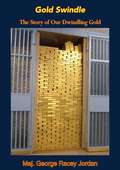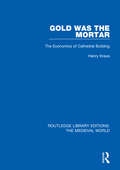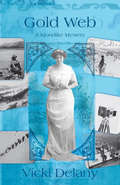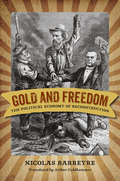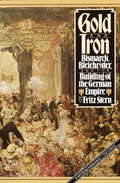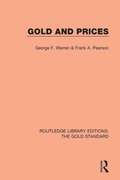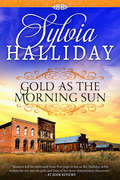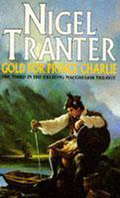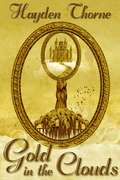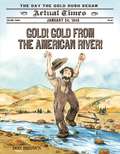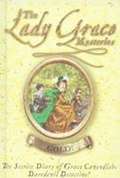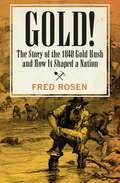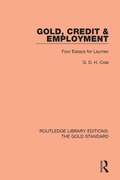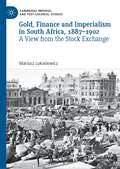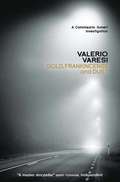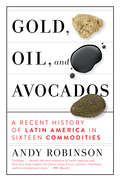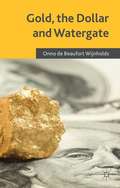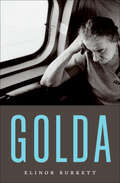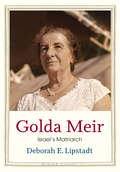- Table View
- List View
Gold Swindle: The Story of Our Dwindling Gold
by Maj. George Racey JordanFirst published in 1959, this book by U.S. Army Air Corps Major George Racey Jordan tells of the loss of U.S. gold reserves under Franklin D. Roosevelt’s administration, when, in an effort to counter the deflation which was paralyzing the economy, Executive Order 6102 declared that all privately held gold of American citizens was to be sold to the U.S. Treasury and the price raised from $20 to $35 per ounce.In Gold Swindle: The Story of Our Dwindling Gold, Major Jordan discusses in detail the gold threat to national security, analyses the government’s power and sources thereof; describes the impending national crisis; and suggests steps to regain the U.S. citizens’ right to own and hold gold.
Gold Was the Mortar: The Economics of Cathedral Building (Routledge Library Editions: The Medieval World #30)
by Henry KrausOriginally published in 1979, Gold Was the Mortar details the financing and the building of the medieval cathedrals at Paris, Amiens, Toulouse, Lyon, Strasbourg, York, Poitiers and Rouen. The book examines the raising of funds and their expenditure, not only on the Cathedrals themselves, but also on the worldly ambitions of the bishop or archbishop, which went beyond the ‘wars and natural disasters’ theory to explain the reasons that caused the delays in building the cathedrals. The book also looks at the issues of building the cathedrals, such as the availability of finance and how for some there was a steady flow of funds while others suffered prolonged breaks. The book also provides case studies of specific cathedrals and examines how places such as York were held up by the internecine disputes with Canterbury; Toulouse and Poiters by the vast expropriations following conquests; and Lyon by the suppression of the commercial and social hierarchy. All the cathedrals depended on the benevolence of patrons, but the part played by the commoners, as revealed in wills and contemporary documents, was an extraordinary contribution, usually exceeding that of the nobility and royalty and sometimes that of the hierarchy itself.
Gold Web: A Klondike Mystery
by Vicki DelanyThe fourth in Delany’s Klondike Mystery series is a madcap romp through the mud of 1898 Dawson City. Book Four of the Klondike Mystery Series by Vicky Delany! The year is 1898. The place is Dawson City, Yukon. A man staggers out of the dusk to collapse at the feet of a startled Fiona MacGillivray, shattering the peaceful calm of a warm July night. Before breathing his last, he gasps two words: "MacGillivray, Culloden." Fiona doesn’t know the man and she would prefer not to find out why he linked her name with the "bloodiest of all battles." As international intrigue abounds and handsome Corporal Richard Sterling of the NWMP searches for the murderer, Fiona’s son Angus takes a job as a photographer’s assistant, a new dancer almost causes a riot, and Fiona tells herself she is not at all bothered by the amount of attention Richard Sterling is paying to the pretty and charming photographer, Miss Eleanor Jennings. This is the latest installment of the Klondike Mysteries, starring Fiona MacGillvary. The first three books of the Klondike Mystery series are Gold Web, Gold Fever, and Gold Mountain.
Gold and Freedom: The Political Economy of Reconstruction (A Nation Divided: Studies in the Civil War Era)
by Arthur Goldhammer Nicolas BarreyreHistorians have long treated Reconstruction primarily as a southern concern isolated from broader national political developments. Yet at its core, Reconstruction was a battle for the legacy of the Civil War that would determine the political fate not only of the South but of the nation. In Gold and Freedom, Nicolas Barreyre recovers the story of how economic issues became central to American politics after the war. The idea that a financial debate was as important for Reconstruction as emancipation may seem remarkable, but the war created economic issues that all Americans, not just southerners, had to grapple with, including a huge debt, an inconvertible paper currency, high taxation, and tariffs. Alongside the key issues of race and citizenship, the struggle with the new economic model and the type of society it created pervaded the entire country. Both were legacies of war. Both were fought over by the same citizens in a newly reunited nation. It was thus impossible for such closely related debates to proceed independently. A truly groundbreaking work, Gold and Freedom shows how much the fate of Reconstruction--and the political world it ultimately created--owed to northern sectional divisions, revealing important links between race and economy, as well as region and nation, not previously recognized.
Gold and Iron
by Fritz SternThis is a book about Germans and Jews, about power and money. It is a book focused on Bismarck and Bleichroder, Junker and Jew, statesman and banker, collaborators for over thirty years. The setting is that of a Germany where two worlds clashed: the new world of capitalism and an earlier world with its ancient feudal ethos; gradually a new and broadened elite emerged, and Bismarck's tie with Bleichroder epitomized that regrouping. It is the story of the founding of the new German Empire, in whose midst a Jewish minority rose to embattled prominence.
Gold and Prices (Routledge Library Editions: The Gold Standard #6)
by George F. Warren Frank A. PearsonThis influential study of the relationship between the prices of gold and other commodities was originally published in 1935. In it the authors attributed the initial cause of the great depression in the US to the reestablishment of the gold standard in many European countries and resulting deflation. The authors' recommendations were successfully implemented by Franklin D. Roosevelt.
Gold and the Settling of the West
by Cheryl Harness Brett Kelly Barbie Heit Alex CanasNIMAC-sourced textbook
Gold as the Morning Sun
by Sylvia HallidayThe award-winning author of Lysette delivers a &“well-crafted tale&” of Western romance &“that will both inspire and pull at your heartstrings&” (RT Book Reviews). Seeking to ease her ailing father&’s mind in his final days, Callie Southgate agrees to marry a mail-order groom coming to Colorado from back east. When she first meets her husband-to-be, she cannot help being timid around the handsome, mysterious man. But when they marry, Callie finds a passion she never knew in his embrace. Con-man and bank robber Jace Greer is given the perfect opportunity to start over when a stagecoach carrying a mail-order groom is ambushed, leaving Callie&’s future husband dead. Taking on the deceased man&’s identity as his own, Jace continues to the Southgate home with the hope of leaving his sinister past behind him. But as true love blooms between Jace and Callie, secrets Jace tried to keep buried begin to surface, threatening their futures—and their lives. Will Callie be able to see beyond Jace&’s transgressions and love him for the man he has become?
Gold for Prince Charlie: MacGregor Trilogy 3
by Nigel TranterIn 1745 the Highlanders limped away from the bitter field of Culloden. Soon the Duke of Cumberland was offering a huge sum for the capture of Prince Charles Edward Stuart, dead or alive. Duncan MacGregor, great-nephew of Rob Roy, volunteers to join the small band of men escorting the Prince to safety. Just one day after the Prince's escape, a large amount of French gold is landed at the very spot from which he has sailed. Thus it is that Duncan becomes involved in a desperate attempt to save Prince Charlie's gold, helped by beautiful, headstrong Caroline Cameron.'Through his imaginative dialogue, he provides a voice for Scotland's heroes' Scotland on Sunday
Gold for Prince Charlie: MacGregor Trilogy 3
by Nigel TranterIn 1745 the Highlanders limped away from the bitter field of Culloden. Soon the Duke of Cumberland was offering a huge sum for the capture of Prince Charles Edward Stuart, dead or alive. Duncan MacGregor, great-nephew of Rob Roy, volunteers to join the small band of men escorting the Prince to safety. Just one day after the Prince's escape, a large amount of French gold is landed at the very spot from which he has sailed. Thus it is that Duncan becomes involved in a desperate attempt to save Prince Charlie's gold, helped by beautiful, headstrong Caroline Cameron.'Through his imaginative dialogue, he provides a voice for Scotland's heroes' Scotland on Sunday
Gold in the 1850s and 1860s (Into Reading, Level T #52)
by Phillip SimpsonNIMAC-sourced textbook <p><p> Gold has always been one of the great sources of wealth. In the 1850s and 1860s, there were major gold rushes all over the world. Some of the largest gold rushes were in the United States, Australia, and New Zealand. Mining methods used were powered by humans and horses.
Gold in the Clouds
by Hayden ThorneAfter his fifteenth birthday, Blythe Midwinter finds himself in a bit of a pickle. It’s high time for him to be a productive member of his family, taking up work he detests in order for his older sister, Molly, to follow her dreams of success as a talented baker. Though the three orphaned Midwinter siblings -- Molly, Bertie, and Blythe -- are lucky enough to work, they still earn only enough to keep themselves clothed and fed. Blythe desperately wishes for more, and it doesn’t help that his best and only friend, Jack Wicket, refuses hard, honest work in favor of good luck as the only means for quick success and instant riches.Blythe’s dreams of a better life get more desperate when he attracts the attention of another boy, the youngest son of a rebellious old artist, whose family rises well above Blythe’s in wealth and station. Embarrassment and shame muddle Blythe’s perceptions of luck, work, and the promise of love -- that is, until Jack Wicket’s foolish decision to exchange his beloved cow for a handful of magic beans forces Blythe to look past castles in the clouds and understand what it is that truly measures a man’s worth.
Gold in the Water: The True Story of Ordinary Men and Their Extraordinary Dream of Olympic Glory
by P. H. Mullen“The tale of a journey of self-awareness, self-belief and the important relationships between coaches and a band of elite swimmers.” —The London TimesIn California, a team of talented young men begin pursuing the most elusive dream in sports, the Olympic Games. The pressure steadily increases as two best friends (a mentor and his protégé) reach the top of the world rankings and unexpectedly find themselves direct competitors. Their teammates include an emerging star methodically plotting to retrace his father’s path to Olympic glory, as well as a super-extraordinary athlete desperate to walk away from it all. Led by one of the most passionate coaches in sports, a brilliant and explosive strategist on a personal quest for redemption, this team of dark horses and Olympic favorites works through escalating rivalries, joyous triumphs, and heartbreaking setbacks.Author P. H. Mullen chronicles their journey to the 2000 Olympic Games and presents one of the most powerful and moving sports books ever written. Boldly sweeping in literary power and pace, this startling book will permanently change how you view the Olympic athlete.It is a fascinating world of suspense and emotion where human desire for excellence rules over all, and where there are no second chances for glory. But above all, Gold in the Water is a triumph of the human spirit.“Mullen does an excellent job not only of conveying the daily torture that elite swimmers go through in the pool but also of giving insight into lesser-known aspects of swimming.” —The New York Times“A superb sports book.” —Booklist (starred review)
Gold! Gold from the American River! (Actual Times #3)
by Don BrownWhen James Marshall found a small, soft shiny stone in a California stream, he knew it could only be one thing: Gold! His cry of discovery would be heard around the world. In the third installment of Don Brown's Actual Times series, Gold! Gold from the American River! is the story of the California gold rush--the uncharted journey across hostile land, the laborious process of panning for gold, the success of savvy entrepreneurs, and the fortunes of the marginalized, from slaves and American Indians to women and foreigners.
Gold!: The Lady Grace Mysteries, Book 7
by Jan Burchett Sara Vogler Grace CavendishPreparations for the wedding of one of Lady Grace's fellow Maids of Honour are interrupted when a shipment of gold, on its way to the Queen, is stolen! The culprit is a single masked horseman, all in black - or is it a gang of ruffians from the forest. The clues seem to point in several different directions and Grace, as Queen Elizabeth's trusty Secret Lady Pursuivant, can't make head nor tail of them. Could one of the newcomers to Court be involved? And will Grace be able to help recover the fortune?
Gold!: The Story of the 1848 Gold Rush and How It Shaped a Nation
by Fred RosenA riveting true account of gold rush fever in mid-nineteenth-century America, rich with the thrilling exploits of daring fortune seekers and dangerous outlaws America was never the same after January 24, 1848. It was on that day that a carpenter named James Marshall discovered a tiny nugget of gold while building a sawmill at Sutter's Fort, just east of Sacramento, California. Marshall's find ignited a fever the nation had never known before, drawing people from all over the country to the West Coast with high hopes of getting rich quick. Over the next six years, three hundred thousand prospectors raced to the California gold fields to make their fortunes, leaving their lands and families behind in order to chase a dream of easy wealth, but all too often encountering a reality of lawlessness, disease, cruelty, and death. A former columnist for the New York Times, author Fred Rosen takes readers back to the seminal moment when the American dream exploded. Chock full of fascinating details, unforgettable characters, and shocking real-life events, the captivating true story of the California gold rush brings an era of unparalleled change to breathtaking life. Rosen's enthralling history of the gold rush of 1848 demonstrates how this golden ideal was supplanted by a culture of selfishness and greed that endures in America to this very day.
Gold, Credit and Employment: Four Essays for Laymen (Routledge Library Editions: The Gold Standard #3)
by G. D. ColeOriginally published in 1930, the essays in this book discuss some of the leading financial controversies of the early 1930s in non-technical language. Rationalisation, the Gold Standard and the problems of currency and credit in their relation to unemployment are among the questions discussed. The volume as a whole is a plea at once for a revision of the (then) current banking policy and for a more energetic effort by the Government to break into the vicious circle of unemployment and under-consumption.
Gold, Finance and Imperialism in South Africa, 1887–1902: A View from the Stock Exchange (Cambridge Imperial and Post-Colonial Studies)
by Mariusz LukasiewiczThis book provides a unique account of the financial and political history of the South African War by analysing the organisation and operations of the Johannesburg Stock Exchange (JSE), the oldest existing stock exchange in the African continent. Identifying the JSE as the nexus between international finance, South African gold mining and British imperialism, the book exposes the financial and political connections between Johannesburg, Pretoria, London, and Paris during the final stage of the imperial ‘scramble for southern Africa.’ Gold mining presented the South African Republic (ZAR) and the whole southern African regional economy with a long-term economic future and new prospects of industrialisation. However, this socio-economic transformation was dependent on extensive capital investments and the institutionalisation of a coercive labour regime based on racial discrimination. This monograph provides the first empirical examination of how international finance, imperial politics, and racialised industrial relations became entrenched in a key financial intermediary in colonial South Africa - first in Kimberley in the Cape Colony, and then in Johannesburg in the ZAR. By studying the Johannesburg capital market’s social microstructures, the author demonstrates how colonial and international financial intermediaries underwrote and financed the largest wave of mining investments in Africa prior to the First World War. Filling an important gap in literature on nineteenth-century British imperialism and Anglo-African-Afrikaner relations, this insightful book uses the JSE as a lens to carefully expose the structures and agency of global finance in the outbreak of the South African War, and the making of South Africa as a unified colonial state.
Gold, Frankincense and Dust: A Commissario Soneri Investigation
by Valerio VaresiParma. A multiple pile-up occurs on the autostrada into the city. A truck transporting cattle skids off the road. Dozens of cows and bulls go on the rampage, injured and crazed. In the chaos, the burned body of a young woman is found at the side of the road. Her death has no apparent link to the carnage. Commissario Soneri is assigned the case. It is a welcome distraction: his mercurial lover Angela has decided to pursue other options, leaving him even more morose than usual. The dead woman is identified as Nina Iliescu, a Romanian immigrant whose beauty had enchanted a string of wealthy lovers. Temptress, muse, angel - she was all things to all men. Her murder conceals a crime and a sacrilege, and even in death she has a surprise waiting for Soneri.
Gold, Frankincense and Dust: A Commissario Soneri Investigation
by Valerio VaresiParma. A multiple pile-up occurs on the autostrada into the city. A truck transporting cattle skids off the road. Dozens of cows and bulls go on the rampage, injured and crazed. In the chaos, the burned body of a young woman is found at the side of the road. Her death has no apparent link to the carnage. Commissario Soneri is assigned the case. It is a welcome distraction: his mercurial lover Angela has decided to pursue other options, leaving him even more morose than usual. The dead woman is identified as Nina Iliescu, a Romanian immigrant whose beauty had enchanted a string of wealthy lovers. Temptress, muse, angel - she was all things to all men. Her murder conceals a crime and a sacrilege, and even in death she has a surprise waiting for Soneri.
Gold, Oil and Avocados: A Recent History of Latin America in Sixteen Commodities
by Andy RobinsonThe past decade has seen major political upheaval in Latin America--from Brazil to Chile to Venezuela to Bolivia--but to understand what happened, ask first where your quinoa and lithium batteries came from...The 21st century began optimistically in Latin America. Left-leaning leaders armed with programs to reduce poverty and reclaim national wealth were seeing results—but as the aughts gave way to the teens, they began to fall like dominos. Where did the dreams of this "pink tide" go? Look no further than the original culprits of Latin American disenfranchisement: resource-rich land and unscrupulous extraction. Recounting the story commodity by commodity, Andy Robinson reveals what oxen have to do with the rise of Jair Bolsonaro, how quinoa explains the mob that descended on Evo Morales, and why oil is the culprit behind the protracted coup in Venezuela. In addition to the usual suspects like gold and bananas which underscored the original plunder of the Americas, Robinson also shows how a new generation of valuable resources—like coltan for smartphones, lithium for electric cars, and niobium for SpaceX rockets—have become important players in the fate of Latin America. And as the energy transition sets mineral prices soaring, Latin America remains at the mercy of the rollercoaster of commodity prices. In Gold, Oil, and Avocados, Robinson takes readers from the salt plains of Chile to the depths of the Amazonian jungle to stitch together the story of Latin America's last decade, showing how the imperial plunder of the past carries on today under a new name.
Gold, Silver, and Bronze: Metal Sculpture of the Roman Baroque (The A. W. Mellon Lectures in the Fine Arts #39)
by Jennifer MontaguAn in-depth look at the exquisite metal sculpture of the Roman baroqueRoman baroque sculpture is usually thought of in terms of large-scale statues in marble and bronze, tombs, or portrait busts. Smaller bronze statuettes are often overlooked, and the extensive production of sculptural silver—much of which is now lost but can be studied from drawings—is frequently omitted from the histories of art. In this book, Jennifer Montagu enriches our understanding of the sculpture of the period by investigating the bronzes that adorn the great tabernacles of Roman churches; gilded silver, both secular and ecclesiastical; elaborately embossed display dishes; and the production of medals. Concentrating on selected pieces by such master sculptors as Bernini and leading metal-workers such as Giovanni Giardini, Montagu examines the often tortuous relationship between patrons and artists and elucidates the relationship between those who provided the drawings or models and the craftsmen who executed the finished sculptures.
Gold, the Dollar and Watergate
by Onno de Beaufort WijnholdsThe book examines the problems that Nixon faced during his presidential term, focusing on economics but the role of politics is also highlighted. The convergence of the gold-dollar crises, oil crises and Watergate imbroglio posed a unique political and economic threat to global stability.
Golda
by Elinor BurkettThis biography of Israel’s first female prime minister is “a fascinating examination of Golda Meir’s public and private selves” (Library Journal).Golda Meir was the first female head of state in the Western-aligned world and one of the most influential women in modern history. A blend of Emma Goldman and Martin Luther King Jr. in the guise of a cookie-serving grandmother, her uncompromising devotion to shaping and defending a Jewish homeland against dogged enemies and skittish allies stunned political contemporaries and transformed Middle Eastern politics for decades to follow. She outmaneuvered Richard Nixon and Henry Kissinger at their own game of Realpolitik, and led Israel through a bloody war even as she eloquently pleaded for peace, carrying her nation through its most perilous hours while she herself battled cancer.In this masterful biography, author and Academy Award–winning documentarian Elinor Burkett paints a vivid portrait of a legendary woman defined by contradictions: an iron resolve coupled with magnetic charm, a kindly demeanor that disguised a stunning hard-heartedness, and a complete dedication to her country that often overwhelmed her personal relationships.“Her engaging portrait of Meir shows history with a female, though not traditionally feminine, face.” —Baltimore Sun“A solidly researched, highly readable portrait of a mesmerizing but, according to Burkett, ultimately lonely woman.” —Publishers Weekly“Leavens the heavy-duty politics with intimate portraits of her personality . . . a welcome arrival to the history shelf.” —Booklist“If anybody has written a better-researched, better-written biography [of Meir], I am unaware of it.” —St. Petersburg TimesIncludes photographs
Golda Meir: Israel's Matriarch (Jewish Lives)
by Deborah E. LipstadtA balanced biography of Golda Meir, who was both adored and abhorred, from award-winning author Deborah E. Lipstadt &“Comprehensive. . . . Always thoughtful. . . . A nuanced account of a leader whose influence endures in the Middle East.&”—Kirkus Review Golda Meir (1898–1978) was the first and only woman to serve as prime minister of Israel. She was born in Kiev into a childhood of poverty, hunger, and antisemitism. When she was five, her father left to find work in America, and a year later the family settled in Milwaukee, Wisconsin. As a teenager she became devoted to Labor Zionism, giving street-corner speeches, and her family&’s home became a destination for Zionist emissaries. Her love for Labor Zionism was so fervent that her boyfriend, Morris Meyerson (her future husband), was often in competition with her dedication to the cause. Zionism prevailed. In 1921, Golda left America for Palestine with Morris and her sister Sheyna. Though the reality of living in Palestine was far from the dream of Zionism, Meir settled on the kibbutz Merhavia and was swiftly appointed to the Histadrut (the General Organization of Hebrew Workers in Palestine). As an ally of the Zionist David Ben-Gurion, Meir played an important role in the Yishuv, the pre-state Jewish community in Palestine; proved an almost singular ability to connect and fundraise with diaspora Jewry, particularly Americans; and served in three pivotal positions following Israel&’s independence: labor secretary of the newly formed state, foreign minister, and Israel&’s fourth prime minister. In tracing the life of Golda Meir, acclaimed author Deborah E. Lipstadt explores the history of the Yishuv and Jewish state from the 1920s through the 1973 Yom Kippur War, all while highlighting the contradictions and complexities of a person who was only the third woman to serve as a head of state in the twentieth century.
